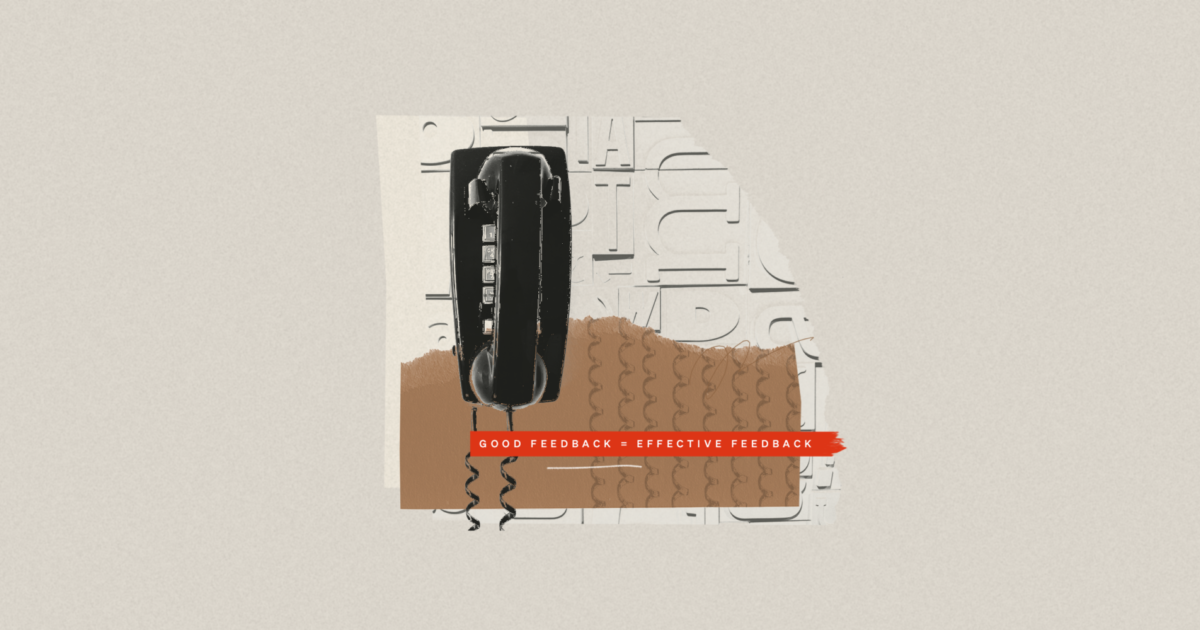It’s the day of receiving your first big deliverable. You’re on pins and needles. Finally you see the email pop up in your inbox. You open up everything, watch the deliverable walkthrough, and start reviewing the document itself. And…it’s feeling okay. Not great, but okay.
Now to tell the folks who made it what needs to improve before we can approve.
Feedback is a cornerstone of any effective rebrand project. Whether you rebrand in-house or with an agency partner, no great work is created in a vacuum. On the flip side, giving notes that are difficult to make sense of, that contradict themselves, or go against already-approved items can blunt momentum on a project or — worst case — stall your rebrand efforts entirely.
{{divider}}
So, what is good feedback?
For creative work, we find that “good feedback” means “effective feedback.” It doesn’t mean that what you offer in response to the work you’ve seen is always rosy and complimentary, it means presenting the whole picture of both what is and is not successful, against whatever strategic goals you’ve established early on. This gives the ones producing the work a precise understanding of where to focus next.
And can I tell you a secret? We at Focus Lab want that whole picture. It tells us both what we can solidify as approved, thereby creating knowns for us to work off of, and what needs polishing to a mirror finish before sharing a final version.
The ABCD format
Struggles to give effective feedback are universal, too. My wife and I were talking one night about a class of design students she was teaching and their struggles with providing effective feedback reviews, where presenters are in front of sometimes 20-30 of their peers.
To help them get to the why behind “I don’t like it,” we brainstormed and realized that good feedback — that is, notes that spur dialogue and help the receiver take decisive next steps — boils down to a simple ABCD format. If your feedback follows this structure, you’re already off to a good start:
- Actionable: The receiver should be able to take your feedback like a baton in a relay race and run the next leg to whatever outcome you’re working toward together.
- Brief: Sometimes in an effort to be thorough with our notes we end up creating a maze the receiver has to navigate to get to what they actually need to do next. Balance being succinct and comprehensive when providing feedback — especially in writing, where there isn’t a conversation to immediately ask a follow-up question.
- Clear: Make it easy to understand what you’re speaking to and why it works or doesn’t. Reference specific details and, even if it feels messy, bring up what comes to mind. We’re experts in translating feedback and are more than happy to figure out the nuances of what you’re trying to communicate.
- Direct: Don’t bury the lede. If something works really well, shout it from the rooftops. If it doesn’t, show you trust your agency partner enough that they’ll hear what you have to say and take steps to improve.
If any of these are challenges, talk to your project manager about them. At Focus Lab, this is precisely the kind of thing that’s great to talk through during our weekly PM Check-Ins, where it’s only our client’s Driver, the Focus Lab Project Manager, and on occasion an additional Focus Lab team member talking through struggles and any other tactical decisions.
Ask yourself…
Additionally, we find that answering the questions below before sharing feedback with a creative partner helps create clearer direction:
- Have I allowed myself time to process what I’m providing feedback on? Sometimes we see something and feel a knee-jerk need to talk about it in that moment, and acting on that can make it tough to articulate your thoughts. Like leftover Thai food after a day in the fridge, sometimes the heat in that moment calms down and becomes easier to manage.
- Am I providing constructive critique, or my personal opinion? You may not like a certain color personally, but strategically it may work wonders for your brand. It’s important to separate out what you may want from what makes the most sense for your org.
- Have I discussed my thoughts with my team already? And are we aligned? It’s common to have different opinions across a project team, and when that happens, it’s vital that you work together to consolidate feedback in a digestible way.
- Do we have consolidated feedback that is clear and actionable? We find that when each person on a client team shares their own thoughts it quickly becomes complicated to navigate, even with a person making final decisions.
{{divider}}
But isn’t feedback about stating what isn’t working?
If it works, why wouldn’t I just move on? Good feedback includes flagging what isn’t working, yes, but it’s also, “Hey this is great, don’t change a thing here.” Hearing those nuggets helps us understand what you like and apply that knowledge elsewhere in our work, spurring solutions for things we haven’t figured out yet.
Additionally, on a human level, it helps to know that we’re doing a good job on something. We care deeply about the work we do here, and take it seriously when we haven’t hit the mark on something. If we’re only hearing what isn’t working, that can easily skew us into thinking we’re on the wrong track overall. Calling out what works buoys our confidence and gives us momentum, along with clarity.
The cost of ineffective feedback
There are two ways to think about this. The first is, what’s the cost to you, the client for whom we want to hang the moon? At the top of the list is time. If our production team doesn’t get effective feedback, it’ll likely mean more meetings, a delayed deliverable, and potentially a change request adding more time, and cost, to the project. All of which can be hard on clients who have busy schedules, real deadlines, and fixed budgets for showing our progress together to executive teams or hard-and-fast plans to execute on our work.
Secondly, ineffective feedback can complicate communication between your team and ours. It requires us to revisit expectations and process, and in some cases, have some hard but necessary convos. We work hard to establish and maintain trust early on with our clients — we give it freely and assume the best from the outset. When we find ourselves in an ineffective feedback loop, it can erode that good faith on both sides.
{{divider}}
Good Feedback Is A Practice
Providing effective feedback is a skill, and one that takes cultivation both for individuals and orgs. And really, it’s for anyone seeking a better outcome to a situation, where everyone involved has a common goal to make or achieve something great together. Whether that’s working with a peer on a proposed design, a partner on a draft of your new brand story, or how you want someone you live with to load the dishwasher.




